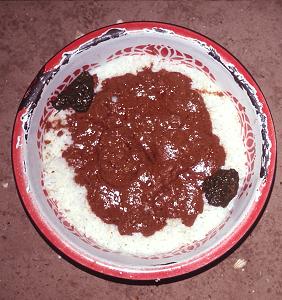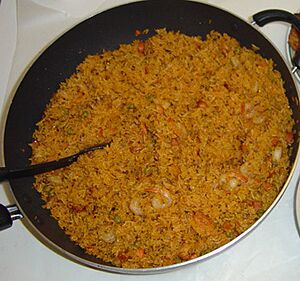West African cuisine facts for kids
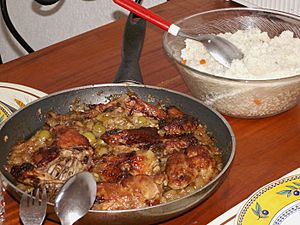
West African cuisine is all about the many different foods found in the 16 countries of West Africa. In this region, many families grow their own food and raise animals. Everyone in the family often has a special job in preparing meals. Local foods include many types of plants and animals. These foods are very important to people who farm and hunt for a living.
The history of West Africa also plays a big part in its food and recipes. Over hundreds of years, people from different cultures, especially the Arab world and later Europeans, brought new ingredients. Many of these ingredients are now key parts of the dishes eaten today.
Contents
History of West African Food
Later, explorers and traders from Portugal, France, and Britain also influenced the food, but not as much as you might think. However, European traders brought exciting new ingredients from the Americas. These included chili peppers, corn, and tomatoes. Today, these are found everywhere in West African cooking, along with peanuts, cassava, and plantains. In return, ships carried African ingredients like black-eyed peas and okra to the Americas.
Around the time of the colonial period, European settlers drew new country borders. They didn't always consider the old borders or different cultures. This meant that tribes were sometimes split, and new colonies had mixed cooking styles. Because of this, it's hard to say exactly what makes, for example, Senegalese food unique from its neighbors.
Even though European colonists brought many new ingredients, they didn't change how people cooked in West Africa very much. The strong cooking traditions have lasted a long time, even with all the new influences.
Main Ingredients
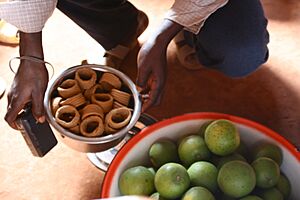
While there are clear differences in the food from one West African country to another, many ingredients are used across the whole region.
Many dishes start with a base of tomatoes, onions, and chili peppers. Cooking these three ingredients together in oil is a very important and almost "sacred" cooking step in West Africa. It's like the "holy trinity" in Cajun cooking in the United States, or sofrito in Spanish-speaking countries.
The most common cooking oil is palm nut oil. It's often used in areas near the coast and gives food a special color, taste, and texture. In drier areas like the Sahel, shea butter is more common. It's known for making food feel rich and smooth in your mouth.
Some countries have their own favorite ingredients. In Ghana, people often use hot pepper, ginger, and maize. Ghanaians believe hot peppers help cool the body and clean it. In Senegal, common ingredients include gumbo, hot pepper, rice, millet, peanuts, ginger, tamarind leaves, and baobab fruit.
Overall, common ingredients in West Africa include baobab tree leaves, grains like sorghum, millet, and fonio, cola nuts, egusi seeds, guinea fowl, melegueta pepper, oil palm, okra, and rice. Okra is often used to thicken soups and stews. Black-eyed peas and sesame are also popular.
Seasonings and Spices
Spices are used less in West African cooking compared to places like North Africa. Cooks use spices and herbs like ginger, coriander, and thyme carefully.
However, chilli peppers are very popular in West Africa, whether fresh, dried, or powdered. They are especially loved in the hotter parts of the region. Chili peppers came to Africa after Christopher Columbus sailed to America. People say that the sweating from spicy chili helps cool the skin. West Africans use a lot of Scotch bonnet chili peppers in their sauces and stews. These peppers are very hot (200,000-300,000 on the Scoville scale) and add a unique flavor and heat. Chili is also thought to help keep food fresh and add taste to plain foods like root vegetables.
The seeds of Guinea pepper (Aframomum melegueta), also called grains of paradise, are also widely used. This spice grows naturally in West Africa. It tastes a bit like peppercorns but also has flavors of cardamom and coriander seed. Grains of paradise were once very valuable in Europe during the Middle Ages.
Sumbala or soumbala is a popular flavoring used across West Africa, similar to a bouillon cube. Women usually make it over several days, often from néré (Parkia biglobosa) seeds. It can also be made from other seeds, and using soybeans for it is becoming more common.
To make sumbala, the seeds are boiled, cleaned, and then left to ferment. This fermentation process gives it a strong smell but also a rich, deep, savory flavor called umami. Salt can be added to help it last longer. This seasoning is traditionally sold in balls or patties that can be stored for several months.
Sumbala is a traditional cooking ingredient, but the less traditional Maggi bouillon cube is also very popular.
African potash (potassium carbonate) is a natural salt made from wood-fire ashes. Cooks use it for flavor and to help some foods cook faster.
Vegetables in West African Meals
Vegetables are a key part of every West African meal. Some common vegetables include black-eyed peas, eggplant, pumpkin and other squashes, okra, and many different kinds of green leafy vegetables. Many of these leafy greens are not well known outside of Africa.
Leaves from the Baobab tree, pumpkin leaves, rosella leaves, sweet potato leaves, and cassava leaves are common in West African kitchens. Cassava leaves contain a natural poison when raw, so they are always boiled first to remove it. Black-eyed peas are used to make a popular fried snack called akara fritters.
Starchy tubers and root vegetables are staple foods. They are served with meat and vegetable dishes, often to balance the heat from the peppers. Cassava, cocoyams, sweet potatoes, plantains, and yams are found everywhere. They are usually boiled and then pounded into a thick, starchy paste called fufu.
Other common starch staples in West Africa, besides root vegetables, include fonio, rice, millet, sorghum, and maize.
Meat and Seafood
In the past, West Africans ate more vegetables and less meat. Today, their diet includes more meats, salt, and fats. Seafood is very popular along the coast, and many dishes mix both fish and meat. Seafood is one of the most common ways to get protein in West Africa.
The seafood industry is so important that it provides jobs for a quarter of the people working in the region. Dried and smoked fish are used to flavor many sauces, stews, and other dishes. They add a deep flavor, similar to how anchovies or bacon are used in other cuisines. Fish is often flaked and fried, or cooked in a sauce made with hot peppers, onions, tomatoes, spices like soumbala, and water.
Chicken is eaten almost everywhere, and chicken eggs are a common food and source of protein. Guinea fowl eggs are also popular. In some areas away from the coast, beef, pork, and mutton are preferred. Goat meat is the most common red meat.
Suya is a popular grilled spicy meat kebab. It's flavored with peanuts and other spices. Street vendors sell it as a tasty snack or evening meal, usually made with beef or chicken.
Popular West African Dishes
Some dishes are found in most West African countries, but they might have different names in different places.
Fufu
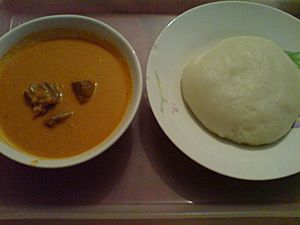
Fufu is usually made from cassava, yams, and sometimes mixed with cocoyam, plantains, or cornmeal. In Ghana, fufu is mostly made from boiled cassava and unripe plantain pounded together. Today, these ingredients are also sold as powders or flours. You can just mix them with hot water to make fufu, which saves the hard work of pounding.
Fufu can also be made from semolina, rice, or even instant potato flakes. Often, it's still made the traditional way: pounding the ingredients in a large mortar with a wooden pestle until it's smooth. If people have modern kitchen tools, they might use a food processor instead.
In West and Central Africa, fufu is usually served as a mound next to a soup (called ọbẹ). After washing their hands, people pinch off a small ball of fufu and make a dip with their thumb. They fill this dip with soup and then eat the ball.
In Nigeria and Ghana, people often swallow the fufu ball whole without chewing. Chewing fufu is actually considered bad manners! So, fufu is not just food, but also a kind of utensil.
One problem with fufu used to be its strong smell, which would linger after the meal. However, new types of cassava and better ways of processing it have removed this smell, making fufu even more popular.
Some soups that can be served with fufu include light (tomato) soup, palm nut soup, groundnut soup, peppersoup, and other soups with vegetables like okra or nkontomire (cocoyam leaves). Soups are often made with different kinds of meat and fish, either fresh or smoked.
Groundnut Stew (Maafe)
Groundnut stew (maafe), also known as mafé or tigadèguèna, is a peanut-based stew that is very common in West Africa. It's especially popular in Senegal, the Gambia, Mali, Guinea, and Cote d'Ivoire. Different versions of maafe are found in many countries across West and Central Africa. As peanut farming grew during the colonial period, maafe became a popular dish all over West Africa, even as far east as Cameroon.
Recipes for this stew can be very different, but at its heart, groundnut stew is cooked with a sauce made from groundnuts (peanuts). It also includes the West African "holy trinity" of tomatoes, onion, and chilies. Common meats used are mutton, beef, or chicken. In the coastal areas of Senegal, maafe is often made with fish. Maafe is usually served with white rice (in Senegal and Gambia), couscous (where West Africa meets the Sahara Desert), or fufu and sweet potatoes in the more tropical areas.
Jollof Rice
Jollof rice, also called benachin, is a very popular dish all over West Africa. It first came from Senegal but has now spread across the whole region, especially in Nigeria and Ghana. The name "jollof" comes from the Wolof people.
There are many ways to make jollof rice. The most common basic ingredients are rice, tomatoes and tomato paste, onion, salt, and red pepper. Beyond that, almost any kind of meat, vegetable, or spice can be added.
The Senegalese version of jollof rice is a bit different and is called ceebu jen. This is the national dish of Senegal. A similar dish, thiebou yapp, or "rice meat," is made with beef, mutton, or other red meat.
Other West African Dishes
- Akara
- Aloko
- Cachupa
- Chin chin
- Couscous
- Draw soup
- Ẹbà
- Egusi soup
- Frejon
- Fried plantain or alloco—a popular version made in Ghana is called kelewele, or hot plantain chips.
- Garri (ground cassava)
- Jollof rice
- Fried fish
- Fufu
- Kedjenou
- Kenkey
- Koko
- Kokoro
- Meat pie
- Moin moin
- Ndolé
- Ngome
- Ogbono soup
- Ogi
- Palaver sauce
- Peanut soup
- Pounded yam
- Puff-puff
- Suya
- Palm nut soup
- Red Red
- Tapalapa bread
- Wagasi
- Yassa au poulet
Drinks
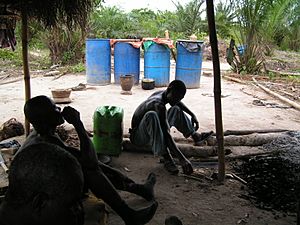
For alcoholic drinks, palm wine is a common choice. It's made from the fermented sap of different types of palm trees. It's usually sold in two types: sweet (less fermented, so it keeps more of the sap's sugar) or sour (fermented longer, making it stronger and less sweet). Beer made from millet is also common and popular.
Dining Etiquette
Eating in West Africa is often a group activity. People usually use their fingers to eat. Water is very important in many West African countries, especially in dry areas. Often, the first thing a West African host will offer a guest is water.
|
See also
 In Spanish: Gastronomía de África occidental para niños
In Spanish: Gastronomía de África occidental para niños


